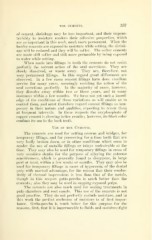Page 699 - My FlipBook
P. 699
THE CEMENTS. 357
of cement, shrinkage may be less important, and their impene-
trability to moisture renders their adhesive properties, which
are so important in this work, much more permanent. When the
harder cements are exposed to moisture while setting, the shrink-
age will be reduced and they will be softer. The softer cements
are made still softer and still more permeable by being exposed
to water while setting.
When made into fillings in teeth the cements do not resist
perfectly the solvent action of the oral secretions. They are
slowly dissolved, or waste away. They are, therefore, not
very permanent fillings. In this regard great differences are
observed. In a few cases cement fillings have done excellent
service for many years, seemingly resisting the action of the
oral secretions perfectly. In the majority of cases, however,
they dissolve away within two or three years, and in many
instances within a few months. We have not yet such a knowl-
edge of the conditions of these variations as will enable us to
control them, and must therefore regard cement fillings as tem-
porary in their nature and qualities, exiiecting to renew them
at frequent intervals. In these respects the oxyi^hosphate of
copper cement is showing better results ; however, its black color
confines its use to the back teeth.
Use of the Cements.
The cements are used for setting crowns and bridges, for
temporary fillings, and for preserving for a time teeth that are
very badly broken down, or in other conditions which seem to
render the use of metallic fillings or inlays undesirable at the
time. They may also be used for temporary fillings in cases of
very sensitive dentin for the purpose of allaying the extreme
sensitiveness, which is generally found to disappear, in large
part at least, within a few weeks or months. They may also be
used for temporary fillings in cases of hyperemia of the dental
pulp with marked advantage, for the reason that their conduc-
tivity of thermal impressions is less than that of the metals,
though in this respect gutta-percha is much better than the
cements ; also they may be used in capping exposed pulps.
The cements are also much used for sealing treatments in
pulp chambers and root canals. This use of the cements is not
good practice. They do not perfectly exclude moisture, and in
this work the perfect exclusion of moisture is of first impor-
tance. Gutta-percha is much better for this purjiose for the
reasons, first, that it is impermeable to fluids and moisture-tight


